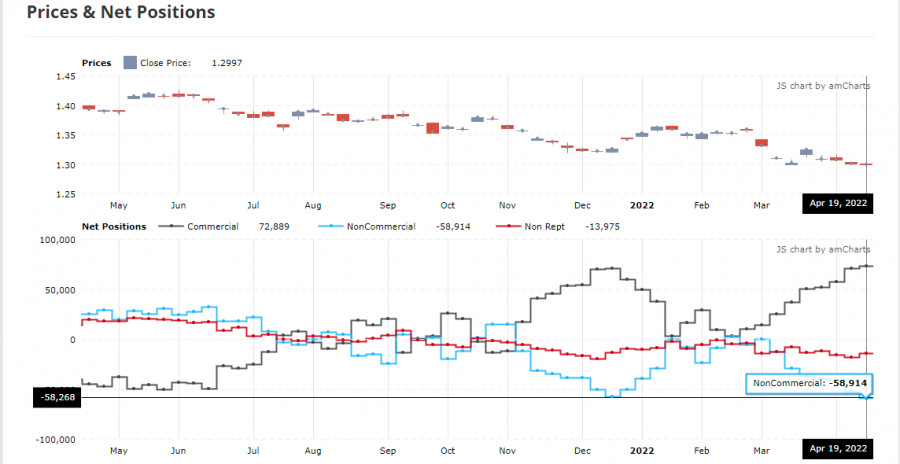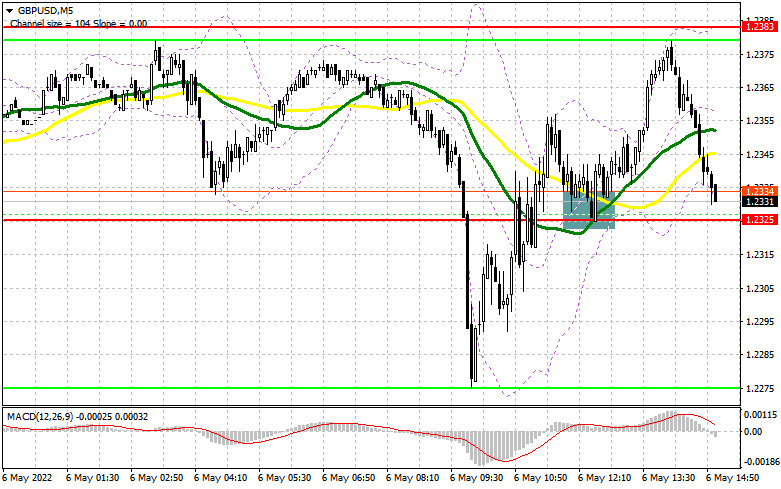In my morning forecast, I paid attention to the level of 1.2325 and recommended making decisions on entering the market. Let's look at the 5-minute chart and figure out what happened. The breakout of this range in the first half of the day occurred without a reverse test from the bottom up. For this reason, I could not enter the market in short positions, and I missed all the downward movement. However, then there was a return to 1.2325 and consolidation on this range with a reverse test from top to bottom, which I noted on the chart. That's where it was necessary to act. As a result, the upward movement was about 60 points. I did not wait for a false breakout at 1.2383, as there were a couple of points missing before the test of this level. And what were the entry points for the euro this morning?
To open long positions on GBP/USD, you need:
In the afternoon, the entire focus is on the data on the American labor market. We are waiting for reports on the unemployment rate and changes in the number of people employed in the US non-agricultural sector. If the data turns out to be better than economists' forecasts, then the demand for the US dollar will return, and the GBP/USD pair will decline to the area of intermediate support of 1.2308 formed by the results of the first half of the day. Only the formation of a false breakdown there, together with weak data on the US labor market, will lead to a signal to open long positions in the expectation of continuing the upward correction and returning to 1.2377, where the moving averages are playing on the side of the pound buyers. It is possible to expect a sharper upward jerk, but only after the speeches of FOMC members John Williams and Rafael Bostic, who will confirm the Fed's softer stance on monetary policy, which will weaken the dollar. Fixing above 1.2377 with a reverse test from top to bottom will lead to a buy signal, followed by movement to the area of the highs of 1.2442 and 1.2505, where I recommend fixing the profits. In the case of a decline in the pound and the absence of buyers at 1.2308, most likely, we will see a renewal of annual lows and another sale in the area of 1.2246. I also advise you to enter the market there only if there is a false breakdown. You can buy GBP/USD immediately on a rebound from the minimum of 1.2185, or even lower - around 1.2122 and only with the aim of correction of 30-35 points within a day.
To open short positions on GBP/USD, you need:
Bears control the market, as in the first half of the day they achieved an update of the weekly minimum, which preserves the downward trend. In the event of a spurt of the pound up after the data on the US economy, only the formation of a false breakdown at 1.2377 will be a sell signal. You can also count on a breakdown of the 1.2308 level, but on the condition that the unemployment rate will decrease and new jobs will show strong growth. A breakout and a reverse test from the bottom up of 1.2308 will lead to the formation of an additional sell signal that can collapse the pound to the lows, to the area of 1.2246, where I recommend fixing the profits. A more distant target will be the 1.2185 area, but it is possible to hope for the implementation of this scenario only after the speeches of the Fed representatives and their more hawkish statements. With the option of further growth of GBP/USD and the lack of activity at 1.2377, a new upward jerk may occur against the background of the demolition of stop orders. In this case, I advise you to postpone short positions to a larger resistance of 1.2442. I also advise you to open short positions there only in case of a false breakdown. You can sell GBP/USD immediately for a rebound from 1.2505, counting on the pair's rebound down by 30-35 points within a day.

The COT report (Commitment of Traders) for April 19 recorded an increase in both short and long positions, but the former turned out to be much larger, which is obvious if you look at the GBP/USD chart. Things are very bad in the UK economy, which was confirmed last week by the Governor of the Bank of England, Andrew Bailey. His statements that the economy is heading towards recession were the last straw holding back the sellers of the pound in the second half of April. As a result, the breakdown of the finished minimum and a new major sale of the pound have already driven the trading instrument below the 26th figure, and it seems that this is not the end. The growth of the consumer price index is steadily moving towards double-digit indicators, and the increasingly complicated situation in the world due to supply chain disruptions against the background of a new wave of COVID-19 in China creates even more problems. The situation will only worsen, as future inflation risks are now quite difficult to assess due to the difficult geopolitical situation, but the consumer price index will continue to grow in the coming months. The situation in the UK labor market, where employers are forced to fight for every employee by offering higher and higher wages, is also pushing inflation higher and higher. The Bank of England's decision on interest rates could further weaken the pound's position if Governor Andrew Bailey decides not to take serious measures to combat inflationary pressures. The COT report for April 19 indicated that long non-commercial positions rose from the level of 35,514 to the level of 36,811, while short non-commercial positions jumped from the level of 88,568 to the level of 95,727. This led to an increase in the negative value of the non-commercial net position from -53 054 to -58 268. The weekly closing price decreased from 1.3022 to 1.2997.

Signals of indicators:
Moving averages
Trading is conducted below 30 and 50 daily moving averages, which indicates an attempt by bears to return to the market.
Note. The period and prices of moving averages are considered by the author on the hourly chart H1 and differ from the general definition of the classic daily moving averages on the daily chart D1.
Bollinger Bands
In the case of a decline, the lower limit of the indicator around 1.2308 will act as support.
Description of indicators
- Moving average (moving average determines the current trend by smoothing out volatility and noise). Period 50. The graph is marked in yellow.
- Moving average (moving average determines the current trend by smoothing out volatility and noise). Period 30. The graph is marked in green.
- MACD indicator (Moving Average Convergence / Divergence - moving average convergence/divergence) Fast EMA period 12. Slow EMA period 26. SMA period 9
- Bollinger Bands (Bollinger Bands). Period 20
- Non-profit speculative traders, such as individual traders, hedge funds, and large institutions use the futures market for speculative purposes and to meet certain requirements.
- Long non-commercial positions represent the total long open position of non-commercial traders.
- Short non-commercial positions represent the total short open position of non-commercial traders.
- Total non-commercial net position is the difference between the short and long positions of non-commercial traders.














